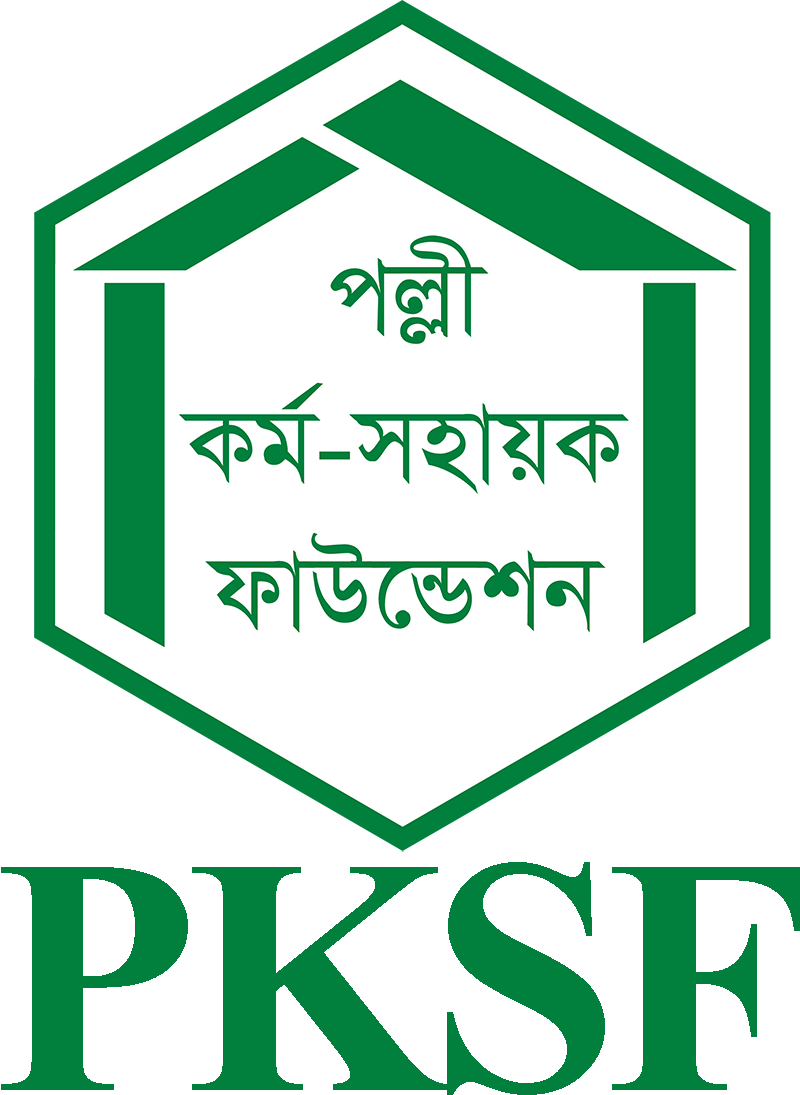Building Drought Resilience in Northwestern Bangladesh
Bangladesh faces a variety of climate-induced hazards such as floods, cyclones, riverbank erosion, droughts, storm surges, and salinity intrusion. The northwestern region—particularly Rajshahi, Naogaon, and Chapainawabganj districts—experiences frequent droughts due to low rainfall, high evapotranspiration, and limited groundwater recharge.
The Extended Community Climate Change Project–Drought (ECCCP-Drought) aims to strengthen the resilience of drought-affected communities by enhancing groundwater recharge, improving surface water availability, and promoting adaptive agricultural practices. The project is being implemented by PKSF in partnership with 18 Implementing Entities (IEs) across 14 drought-prone upazilas of Rajshahi, Naogaon, and Chapainawabganj districts.
Project Goal
To enhance the resilience of vulnerable rural communities by ensuring sustainable water access, promoting drought-tolerant crops, and strengthening institutional capacity to manage climate-induced droughts.
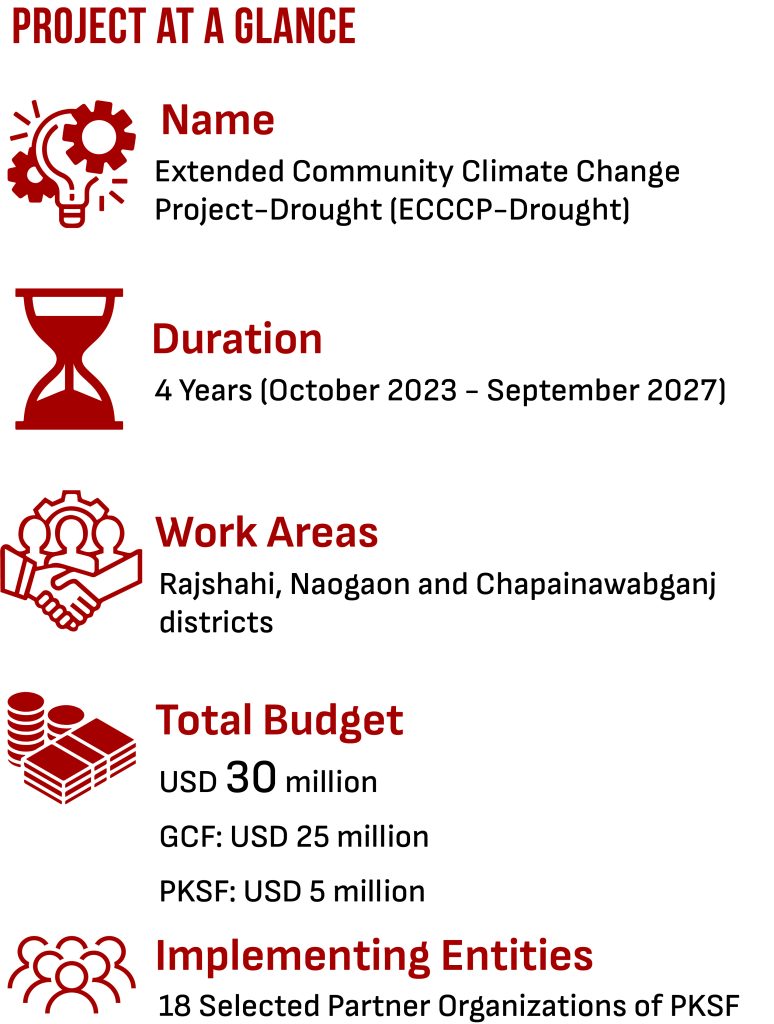
Key objectives
- Increase surface- and groundwater availability for irrigation and household use.
- Promote low-water-demand crops to cut irrigation needs by up to 70 percent.
- Empower local institutions and community groups to plan and manage climate-resilient interventions.
- Reduce the burden on women through improved access to safe water sources.
Component and Outputs
Component 1: Improved institutional and technical capacities to address climate change-induced drought
This first Component intends to build capacities among government institutions and NGOs to address climate change impacts, particularly related to droughts. This will be achieved by improving capacities among different interrelated scales of institutional and community organizations: at the ministry, subnational, and at community levels.
Output 1.1 Enhanced capacities of government institutions to implement and monitor water resources management and climate change adaptation projects.
Output 1.2 Knowledge and technical capacities of climate change adaptation interventions improved.
Output 1.3 Communities are organized and aware of climate change issues and potential responses.
Component 2: Increased availability of surface and ground water for irrigation and drinking.
In drought-prone districts where annual rainfall averages only 1,400 mm—far below the national mean of 2,300 mm—clay-rich soils hinder rainwater infiltration, slowing groundwater recharge. As a result, shallow tube wells often run dry during droughts. Component 2 of the ECCCP-Drought project addresses this challenge by restoring 140 km of canals and 300 ponds, and installing 2,500 rooftop and 40 pond-based Managed Aquifer Recharge (MAR) systems to harvest and inject rainwater into aquifers. Using piezometers, the project monitors water table improvements while ensuring reliable water for irrigation and household use. By project completion, around 215,000 people in Rajshahi, Naogaon, and Chapainawabganj will gain sustainable access to surface and groundwater resources year-round.
Output 2.1 Improved storage of surface water.
Output 2.2 Improved recharge of aquifers.
Component 3: Drought resilient livelihoods created through a sustainable agricultural production.
Component 3 promotes drought-adaptive cropping patterns to enhance agricultural resilience and water efficiency. Each cropping cycle will include at least three diverse crops per year, selected for moisture tolerance, short growth duration, and low water demand. Recommended combinations include BRRI Dhan-56 (rice), BARI Gom-24 (wheat), and BARI Mung-6 (pulse). In addition, fruit trees and cotton, known for their drought tolerance and economic value in the Barind region, will be encouraged. Farmers, organized under CCAGs, will receive quality seeds and technical support through DAE and BADC. This approach is expected to increase productivity and incomes while reducing irrigation needs by up to 70%.
Output 3.1 Drought-resilient crops are adopted by farmers.
Major Activities
Pond Re-excavation
With the financial and technical support from the ECCCP-Drought project and highly involvement of the communities, ponds of selected areas in Naogaon, Rajshahi and Chapainawabganj districts underwent a strategic re-excavation. It has increased the water retention capacity from its existing status to about 2.5 meters. The main purposes of the re-excavation are nothing but to enhance domestic water usage, provide subsidized irrigation support for rice fields and mango orchards, ensure water availability for household purposes. In addition to enhance the surface water availability, this re-excavation transformed the ponds in to year-round resources from the seasonal water bodies. A community-led approach was introduced to provide pond water for irrigation at a subsidized cost, ensuring equitable access and preventing overuse.
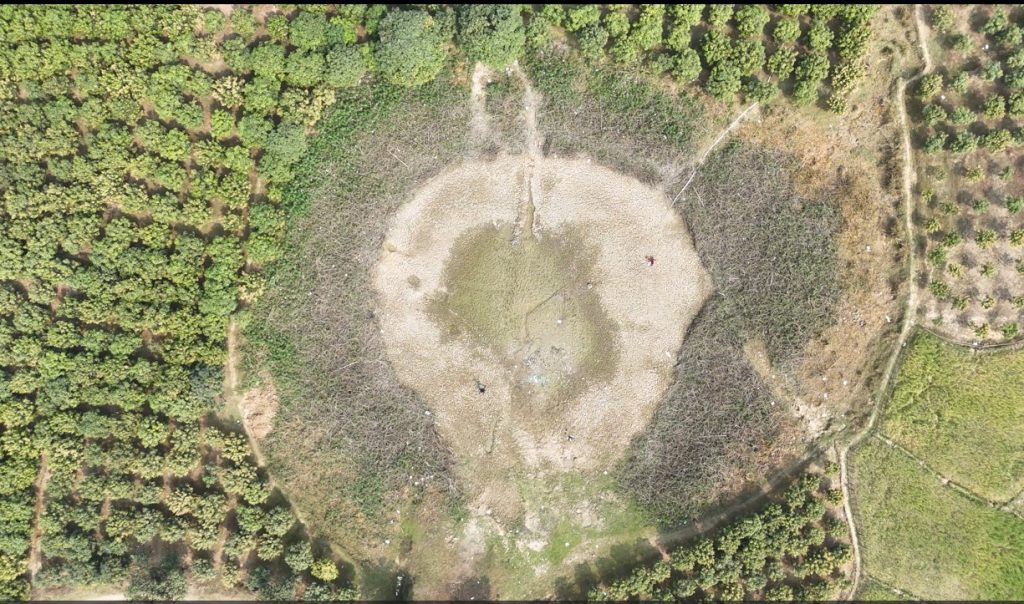
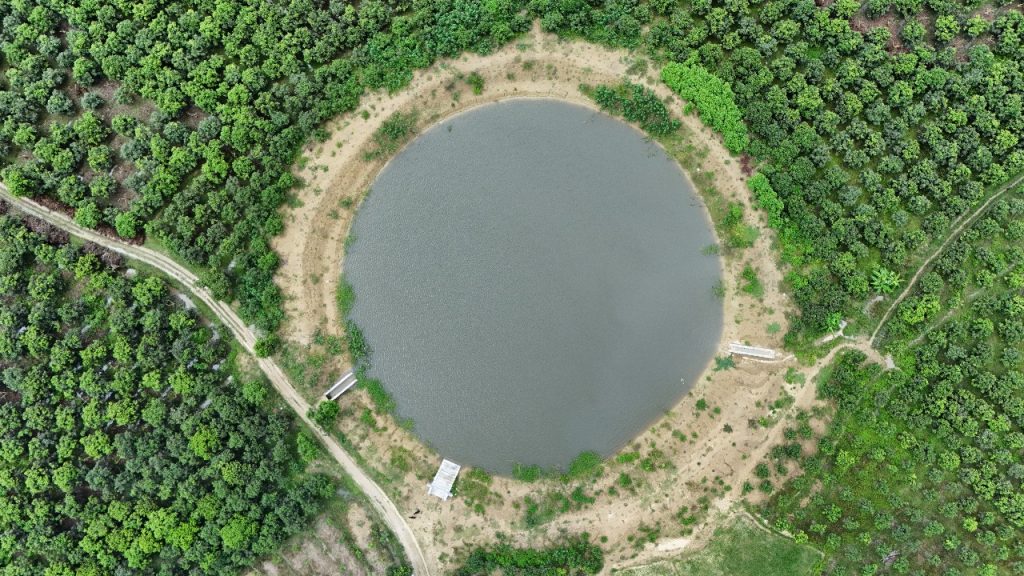
A pond before (left) and after (right) its re-excavation at Patnitala, Naogaon (IE: Shataphool Bangladesh)
Canal Re-excavation
Canals are one of the best sources of surface water. Especially the farmers of high barind tract (HBT) region, such as the areas of Naogaon, Rajshahi and Chapainawabganj districts strongly depend on the water of canals for irrigating their agricultural crop lands. It is also connected with national food security and gross domestic product (GDP) growth of the country. But scarcity of water in the canals are hindering the crop production heavily in the above-mentioned regions. Under current climate regime, water scarcity or drought is intensifying locally and globally. With a specific terrain landform in the HBT region, lends itself to fast runoff. Additionally, thick clay layer that allows extremely slow percolation of water in the ground water aquifer, makes the region more vulnerable to water scarcity and drought. Considering the ground, PKSF with his partner organizations has undertaken to re-excavate 140 km of canals in the selected unions of 14 upazilas of Naogaon, Rajshahi and Chapainawabgani districts. The goal of this re-excavation is to store rainwater for irrigation purposes and increase water retention capacity in the surface water bodies there.
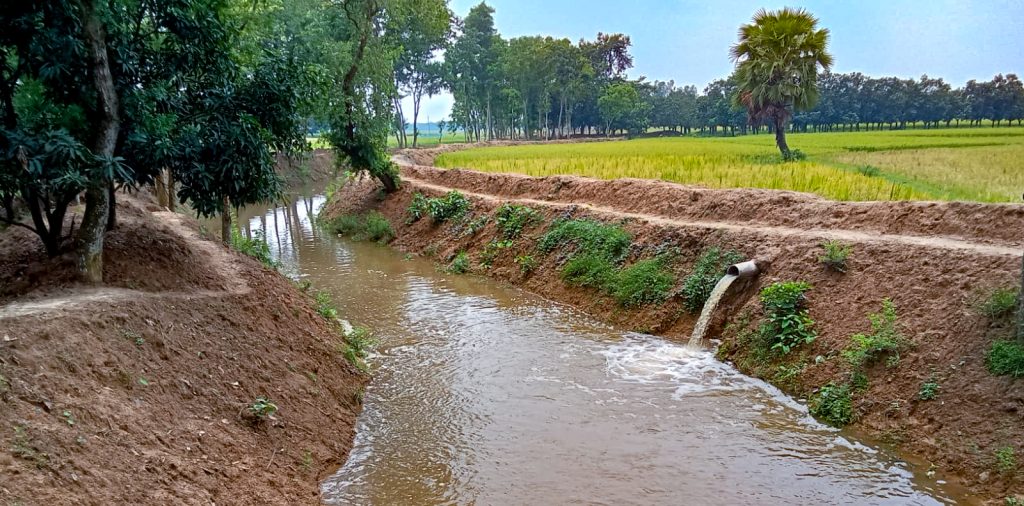
A canal at Tanore in Rajshahi is with full of water after its re-excavation
Managed Aquifer Recharge (MAR) System Installation
The rate of aquifer depletion tends to be critical in most of the areas of HBT region. One of the most critical causes refers to use of excessive groundwater, especially for Boro rice cultivation. In addition, the following causes may consider for the depletion of aquifer in the HBT region:
- Reduced annual average rainfall;
- Increased irrigation;
- Impacted due to climate change locally;
- Hindered water infiltration due to clay-rich soil;
- Declined water table;
- Impacted ecology;
Aligning the national policies and programmes, PKSF has been establishing the MAR systems at the roof-tops and adjacent to ponds. The project has set its target to install 2500 roof-top MAR systems in its tenure, up to 2027. It is estimated that 2500 MAR systems will inject 560,000 m3 of water into the aquifer annually. In addition, this will improve access to water for about 25,000 persons in every year.
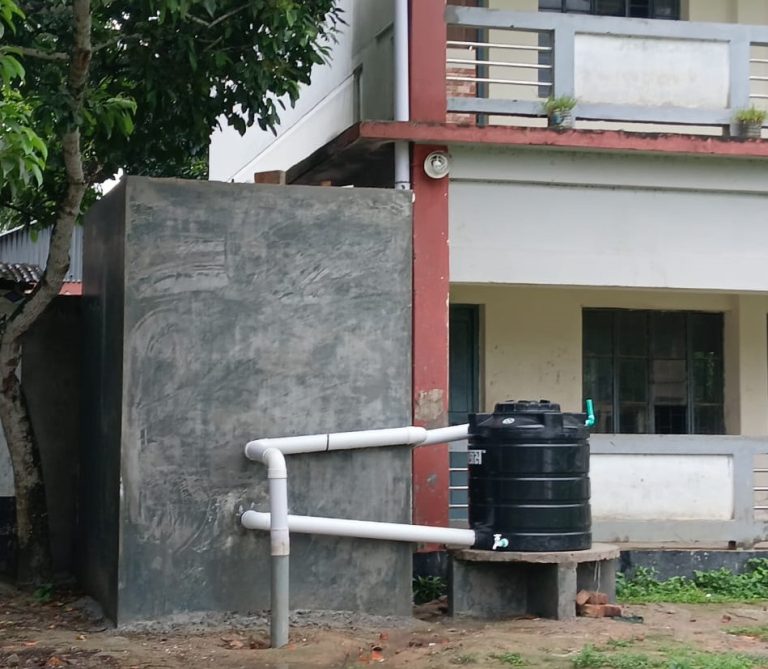
A completed Rooftop MAR system at Patnitala, Naogaon
Drought-tolerant Crop and Fruit Cultivation
Basically, because of the terraced landforms, rainwater quickly drains in to canals or rivers. As a result, the soil cannot retain moisture. In addition, the average temperature increase in the region is almost double and the average rainfall is almost half that of the national level. Due to all these reasons, tends to drought is high in Barind region and it is increasing day by day. Agricultural activities in Barind region are heavily affected by drought.
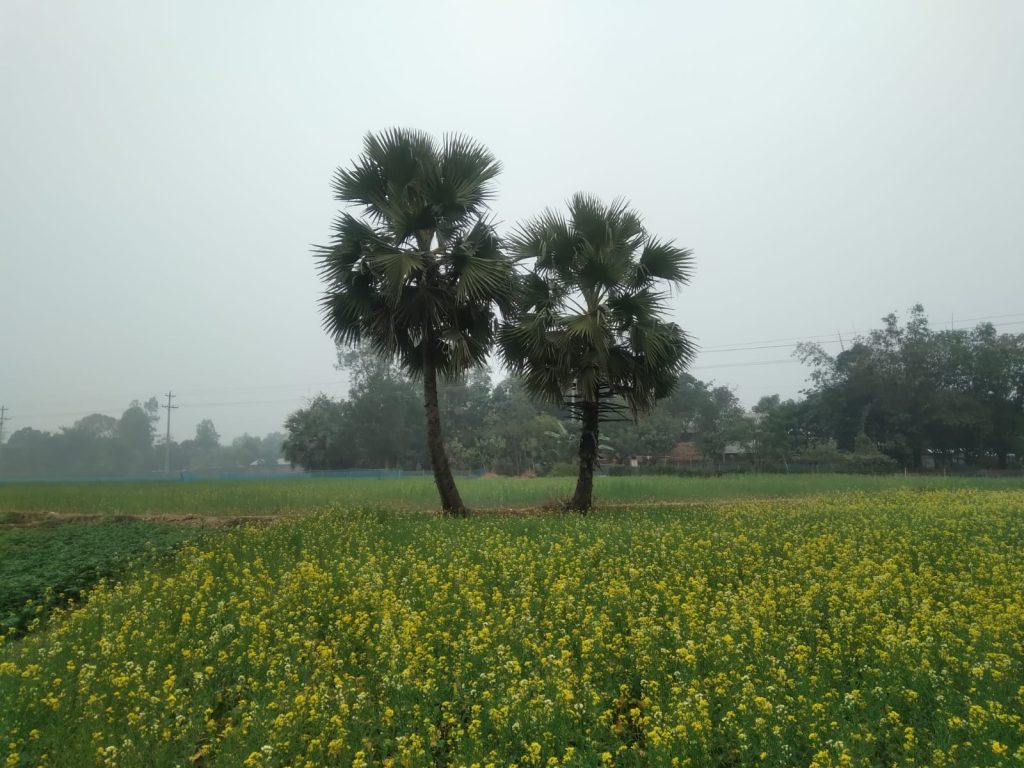
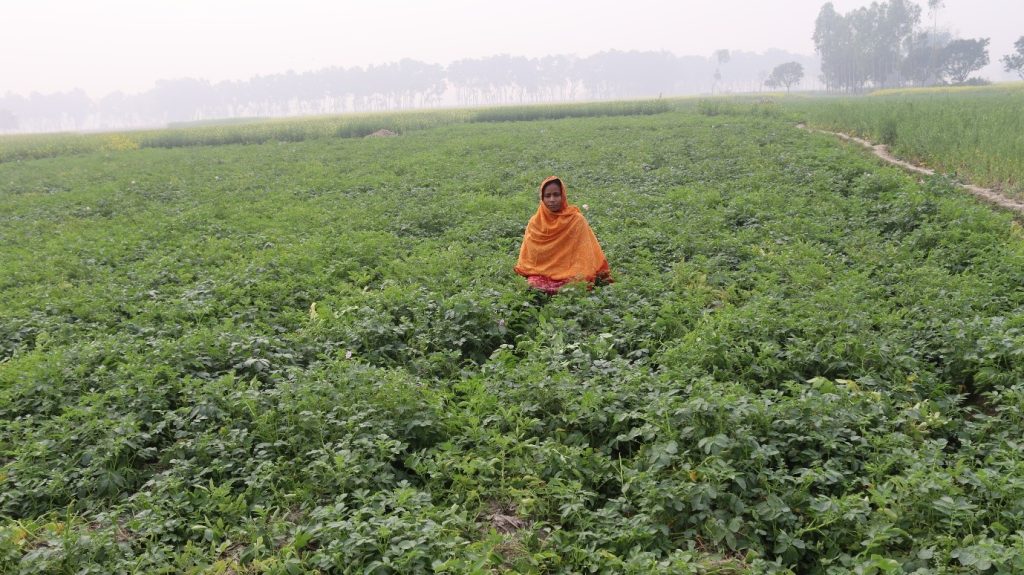
Considering the importance of the matter, the ECCCP-Drought project has taken initiative to expand water efficient and drought resistant crop cultivation among a total of 15,000 farmers in 14 upazilas under Rajshahi, Naogaon and Chapainawabganj districts. Under the project, about three and a half thousand farmers have been given day-long training on “Cultivation of Drought-tolerant Fruits and Crops”. It is expected that the project will be able to bring about a significant and positive change in the agricultural grain production of Barind region by expanding the cultivation of drought tolerant fruits and crops.
SIGNIFICANT ACTIVITIS OF THE PROJECT AT A GLANCE
Name of Activity | Total Target | Achievement as of September 2025
|
Formation of Climate Change Adaptation Group (CCAG) | 600 | 600 |
Training to CCAG Members on Drought-tolerant Crop and Fruit Cultivation | 15000 households | 4600 households |
Re-excavation of Ponds | 300 | 65 |
Re-excavation of Canals | 140 km | 24 km |
Installation of Rooftop MAR Systems | 2500 | 558 |
Installation of Pond-based MAR Systems | 90 | 0 |
Training to NGOs on Climate Change | 100 NGOs | 100 NGOs |
Expected Impacts
By the end of the project in 2027, ECCCP-Drought will:
- Improve access to water for over 215 ,000 people.
- Recharge depleted aquifers by 560 ,000 m³ per year.
- Reduce irrigation water demand in the dry season by up to 70 percent.
- Strengthen institutional capacity to manage climate risks.
- Contribute directly to SDG 6 (Clean Water and Sanitation) and SDG 13 (Climate Action) as well as national goals under the Bangladesh Delta Plan 2100
Project Locations by the Implementing Entities (IEs)
Based on the intensity and frequency of drought, the project is being implemented in the following upazilas and districts of Bangladesh:
Sl. | District | Upazila (Sub-district) | Name of the IEs |
1 | Chapainawabganj | Nachole | Mousumi |
2 | Chapainawabganj Sadar | Proyas Manobik Unnayan Society | |
3 | Gomostapur | Resource Integration Centre (RIC) | |
4 | Rajshahi | Tanore | SKS Foundation |
5 | Godagari | SHAPLA Gram Unnayan Sangstha | |
6 | Naogaon | Godagari | WAVE FOUNDATION |
7 | Naogaon Sadar | National Development Program (NDP) | |
8 | Niamotpur | Ghashful | |
9 | Niamotpur | RDRS-Bangladesh | |
10 | Patnitala | Shataphool Bangladesh | |
11 | Patnitala | Eco-Social Development Organization (ESDO) | |
12 | Shapahar | Gram Unnayan Karma (GUK) | |
13 | Porsha | TMSS | |
14 | Mohadevpur | Society for Social Service | |
15 | Dhamoirhat | JAKAS Foundation | |
16 | Manda | Dabi Moulik Unnayan Sangstha | |
17 | Manda | Village Education Resource Center (VERC) | |
18 | Bodogachi | Joypurhat Rural Development Movement (JRDM) |
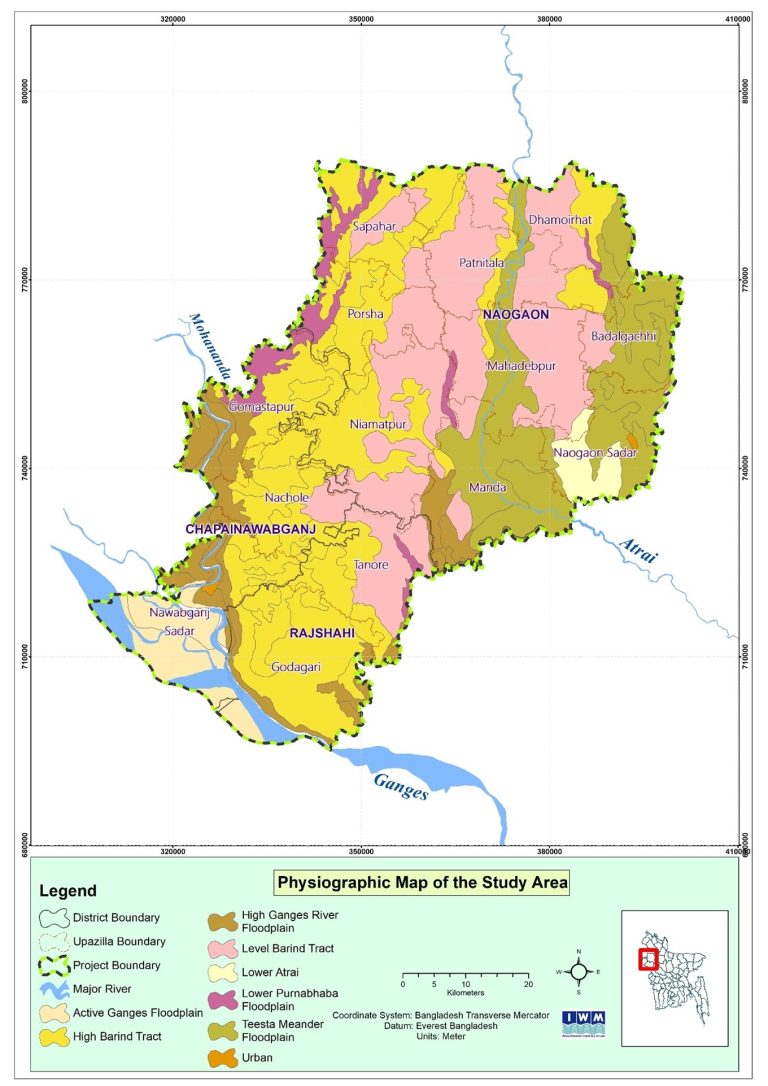
Fig: Physiographic Map of the Project Locations
